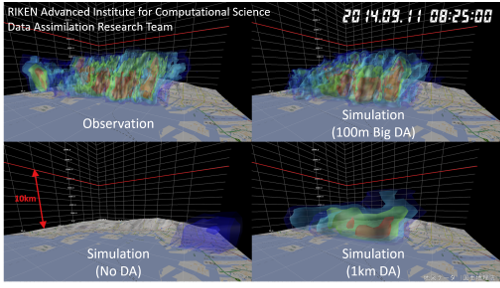Aug. 9, 2016 Press Release Computing / Math
K computer and high-tech weather radar come together to predict sudden torrential rains
Today, supercomputer-based weather predictions are typically done with simulations that use grids spaced at least one kilometer apart, and incorporate new observational data every hour. However, due to the roughness of the calculations, these simulations cannot accurately predict the threat of torrential rains, which can develop within minutes when cumulonimbus clouds suddenly develop. Now, an international team led by Takemasa Miyoshi of the RIKEN Advanced Center for Computational Science (AICS) has used the powerful K computer and advanced radar observational data to accurately predict the occurrence of torrential rains in localized areas.
The key to the current work, to be published later this month in the August issue of the Bulletin of the American Meteorological Society, is “big data assimilation” using computational power to synchronize data between large-scale computer simulations and observational data.
Using the K computer, the researchers carried out 100 parallel simulations of a convective weather system, using the nonhydrostatic mesoscale model used by the Japan Meteorological Agency, but with 100-meter grid spacing rather than the typical 2-kilometer or 5-kilometer spacing, and assimilated data from a next-generation phased array weather radar, which was launched in the summer of 2012 by the National Institute of Information and Communications Technology (NICT) and Osaka University. With this, they produced a high-resolution three-dimensional distribution map of rain every 30 seconds, 120 times more rapidly than the typical hourly updated systems operated at the world’s weather prediction centers today.
To test the accuracy of the system, the researchers attempted to model a real case—a sudden storm that took place on July 13, 2013 in Kyoto, close enough to Osaka that it was caught by the radars at Osaka University. The simulations were run starting at 15:00 Japanese time, and were tested as pure simulations without observational data input as well as with the incorporation of data every 30 seconds, on 100-meter and 1-kilometer grid scales. The simulation alone was unable to replicate the rain, while the incorporation of observational data allowed the computer to represent the actual storm. In particular, the simulation done with 100-meter grids led to a very accurate replication of the storm compared to actual observations.
According to Miyoshi, “Supercomputers are becoming more and more powerful, and are allowing us to incorporate ever more advanced data into simulations. Our study shows that in the future, it will be possible to use weather forecasting to predict severe local weather phenomena such as torrential rains, a growing problem which can cause enormous damage and cost lives.”
The research was carried out by researchers from RIKEN AICS together with the Meteorological Research Institute, the University of Buenos Aires, NICT, Osaka University, and the Meteorological Satellite Center.
The following two research projects funded by the Japan Science and Technology Agency (JST) CREST programs contributed to this achievement: "Innovating ‘Big Data Assimilation’ technology for revolutionizing very-short-range severe weather prediction" (led by Dr. Takemasa Miyoshi of RIKEN), a project in the research area of Advanced Application Technologies to Boost Big Data Utilization for Multiple-Field Scientific Discovery and Social Problem Solving (Research Supervisor: Prof. Yuzuru Tanaka of Hokkaido University), and "EBD: Extreme Big Data – Convergence of Big Data and HPC for Yottabyte Processing" (led by Prof. Satoshi Matsuoka of the Tokyo Institute of Technology with Dr. Takemasa Miyoshi of RIKEN acting as co-PI), which is a project in the Advanced Core Technologies for Big Data Integration area (Research Supervisor: Prof. Masaru Kitsuregawa of the National Institute of Informatics). This research used computational resources of the K computer provided by the RIKEN Advanced Institute for Computational Science through the HPCI System Research project (Project ID: hp150019 and hp160162 for Research on "Big Data Assimilation" for predicting sudden torrential rains, and Project ID: ra000015 for Research and development on fundamental approaches to integrating data analyses and numerical simulations)
Reference
T. Miyoshi, M. Kunii, J. Ruiz, G.-Y. Lien, S. Satoh, T. Ushio, K. Bessho, H. Seko, H. Tomita, and Y. Ishikawa, "“Big Data Assimilation” Revolutionizing Severe Weather Prediction", Bulletin of the American Meteorological Society, doi: 10.1175/BAMS-D-15-00144.1
Contact
Team Leader
Takemasa Miyoshi
Data Assimilation Research Team
Research Division
RIKEN Advanced Institute for Computational Science
Jens Wilkinson
RIKEN International Affairs Division
Tel: +81-(0)48-462-1225 / Fax: +81-(0)48-463-3687
Email: pr@riken.jp

Distribution of thunderclouds on September 11, 2014
Top left: Observational data from the phased array weather radar; Bottom left: The simulation without integration of observational data; Top right: Results of a simulation with big data assimilation on a 100-meter grid; Bottom right: Results of a simulation with data assimilation on a 1-kilometer grid
Simulating sudden torrential rains with the K computer
